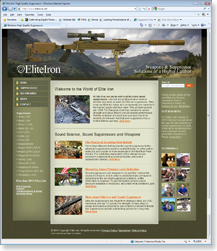
Sample page copy for EliteIron.net, a web site about weapons systems, sound
suppressor solutions and accessories for the military, law enforcement and discerning civilian shooters.
ELITIRON.NET WEB SITE
Elite Iron Weapons and Suppressor Solutions of a Higher Caliber.
All Elite Iron Suppression Systems' tubes are fabricated from nonmagnetic, 304 stainless steel and trued for concentricity. The internal parts, made from 17-4 PH stainless steel, are machined from solid billets on new USA made HAAS CNC equipment. The internal baffle design is a heavily modified so-called "K"-type. Knurled bands at the attachment end of the sound suppressor aid in the installation and removal of the unit and serve as tactile locator bands in subdued light. All of the units' components are individually checked prior to assembly, which is entirely by hand. A NIC Industries CeraKote™ finish is used on all Elite Iron sound suppressors unless the customer requests a sandblasted finish.
Located in Potomac, Montana, Elite Iron is a full service company with a significant investment in tooling that includes CNC lathes and mills and other equipment designed to turn out the best quality suppressors, muzzle brakes, and system solutions possible. The owners of Elite Iron are serious shooters and are dedicated to providing the level of service and commitment that they appreciate themselves.
Dale Poling, the principal behind Elite Iron Suppressor Systems, is a highly experienced professional machinist with more than 20 years of background in the area of precision impact testing prototype weapons parts for various US small arms manufacturers. He has ten years of experience in competitive short and long range match shooting. He is a former member of the National Bench Rest Shooting Association (NBRSA), the National Tactical Shooting Association (NTSA), and the Fifty Caliber Shooters Association, and he holds the FCSA 1996 world record for 1,000-yard .50 caliber BMG rifle.
Kathy Poling, a well known Class III and weapons dealer, has an extensive background in shooting sports. Kathy's 30+ year reputation is well known in the firearms community and at events such as the SHOT SHOW, the Small Arms Review show, and Knob Creek Machine Gun Shoot, to name but a few venues. A fixture in the firearms culture for many years, Kathy is responsible for the management and sales of Elite Iron products and services at the couple's peaceful Montana location where they like things nice and quiet.
Measuring Sound Pressure Level Reduction.
Sound suppressors by definition are designed, in this application, to suppress the sound of a firearm. Some do, and some don't. Sound suppressors were most often evaluated and compared by a logarithmic ratio called the decibel (dB) [see below]. Yet, somewhat mysteriously, in recent times the largest and most prominent manufacturers of sound suppressors have stopped any reference whatsoever to the specific sound pressure level reduction of their product line in their catalogs. The intriguing question is, of course, why? When asked, they will say it's too easy for less-than-reputable manufacturers to cite phony data. Say again? Since when have the lies of others prevented anyone from presenting valid data obtained by means of industry and government accepted procedures? We are justifiably proud of the sound pressure level reduction that is produced by our sound suppressors. The data presented here has been obtained by reliable outside independent sources and by our own testing, which is conducted in rigid conformity with US military testing procedures. Furthermore, our customers want to make comparisons with the sound suppressors of other manufacturers and expect to see quantitative data in this regard.
Measuring Sound Pressure Level Reduction - How it's done.
We use the industry standard Bruel & Kjaer Model 2209 sound meter. It is re-calibrated annually by Bruel & Kjaer to ensure that it functions properly. We use the US Military standard testing procedure for sound suppressors, which stipulates that the meter should be placed one meter away from and 90-degrees to the side of the firearm's muzzle and held parallel above the ground at a height of 1.6 meters over a non-reflecting surface. The muzzle is positioned perpendicular to the microphone before each shot.
Ten non-suppressed readings are taken first and then averaged to provide a baseline figure. Then, ten sound-suppressed readings with 3 to 5 minute cooling intervals between each shot are taken. This data is also averaged and the result subtracted from the baseline figure. This figure represents the degree of sound suppression.
The ambient temperature, humidity, barometric pressure, elevation above sea level and date are also recorded during the testing process. It's important to note that there will always be minor day-to-day variations in the data obtained as a consequence of changes in the weather parameters.
Using the procedures described above, the actual sound pressure level reductions and specifications of the Elite Iron suppressors are presented on this web site.







